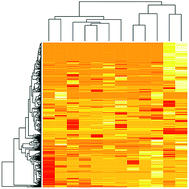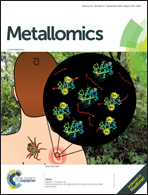New aspects of iron–copper crosstalk uncovered by transcriptomic characterization of Col-0 and the copper uptake mutant spl7 in Arabidopsis thaliana†
Abstract
Iron (Fe) and copper (Cu) are essential micronutrients for energy metabolism and reactive oxygen species (ROS) scavenging. Some Cu-containing proteins can be substituted with Fe-containing proteins, and vice versa, while several Arabidopsis genes are regulated by both metals. Few details of how plants coordinate Fe–Cu crosstalk are known. Gene expression was measured in the roots and rosettes of Fe, Cu, and simultaneously Fe and Cu deficient WT plants and a mutant of the Cu-uptake transcription factor SPL7. The spl7 mutant accumulated excess Fe under normal conditions, and lower Fe supply rescued the growth phenotype and normalized the Fe : Cu ratios. Most Fe regulated genes were expressed similarly in the WT and spl7 mutant, although at higher fold-change levels in spl7 mutants. Expression patterns indicated that both SPL7 and the FIT Fe uptake transcription factor influenced the expression of many key Fe uptake genes. Most notably, the newly discovered IMA/FEP genes and the subgroup Ib bHLH genes, which are upstream of Fe uptake responses, were repressed in the WT under Cu deficiency. Several AP2/ethylene response factor (AP2/ERF) genes and other redox homeostasis network genes were derepressed in spl7 mutants. Together, we present new information about Fe–Cu crosstalk in plants that could be applied for developing abiotic stress tolerant crops.



 Please wait while we load your content...
Please wait while we load your content...